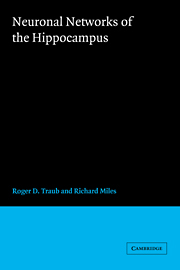Book contents
- Frontmatter
- Contents
- Acknowledgments
- Prologue
- 1 The hippocampus in context
- 2 Physiology of single neurons: voltage- and ligand-gated ionic channels
- 3 Synaptic function and organization of the CA3 region
- 4 The single-cell model
- 5 Model of the CA3 network
- 6 Collective behaviors of the CA3 network: experiment and model
- 7 Collective behaviors of the CA3 network: spontaneous oscillations and synchronized synaptic potentials
- 8 Field effects
- 9 Theoretical approaches: mathematical neural networks
- Conclusion
- Notes
- References
- Index
Conclusion
Published online by Cambridge University Press: 05 February 2012
- Frontmatter
- Contents
- Acknowledgments
- Prologue
- 1 The hippocampus in context
- 2 Physiology of single neurons: voltage- and ligand-gated ionic channels
- 3 Synaptic function and organization of the CA3 region
- 4 The single-cell model
- 5 Model of the CA3 network
- 6 Collective behaviors of the CA3 network: experiment and model
- 7 Collective behaviors of the CA3 network: spontaneous oscillations and synchronized synaptic potentials
- 8 Field effects
- 9 Theoretical approaches: mathematical neural networks
- Conclusion
- Notes
- References
- Index
Summary
Our primary goals in this book have been two. The first has been to determine if our current experimental data concerning cellular physiology and synaptic connections suffice to account for various types of collective phenomena exhibited by the in vitro CA3 region. The answer here is yes, up to a point. Many details concerning the quantitative electrophysiology of single neurons, the spatial structure of synaptic connections, and the events required to elicit synaptic plasticity remain to be elucidated, as do the implications of such details for population behavior. The second goal has been to obtain insight into the hippocampus as a (perhaps) novel physical system. Is a particular collective behavior analogous to a well-understood physical paradigm, such as a chain reaction or a time-dependent percolation? Or are there, alternatively, interesting new principles at work, perhaps pertinent to basic questions of brain function? Here again, the answer is yes, up to a point. Synchronized bursts in the presence of picrotoxin appear analogous to a chain reaction, and the ideas of percolation have proved helpful intuitively, if not yet quantitatively. Hippocampal physiology and mathematical physics may yet prove to have something to offer each other. It is our view that “conventional” neural network models, layered neural networks, and symmetric spin-glass models are not appropriate for description of the CA3 region of the hippocampus, although modified, more complex “spin models” may well prove to be helpful.
- Type
- Chapter
- Information
- Neuronal Networks of the Hippocampus , pp. 223 - 224Publisher: Cambridge University PressPrint publication year: 1991



